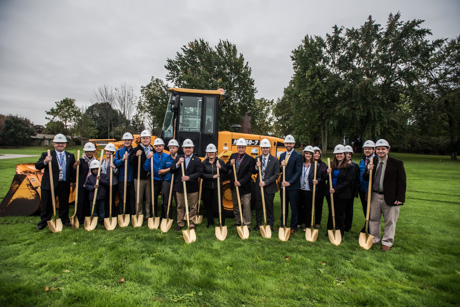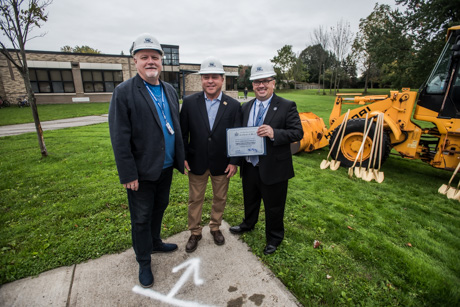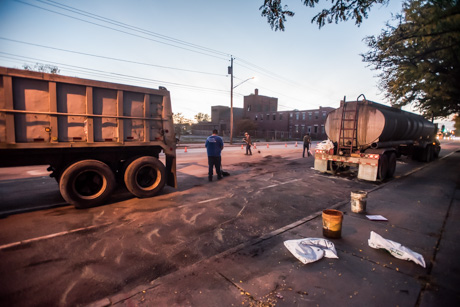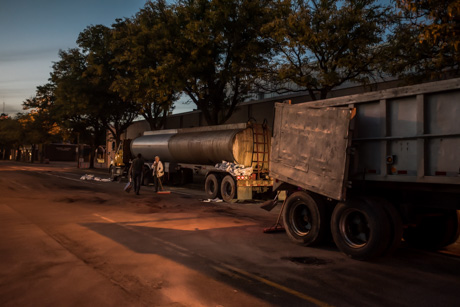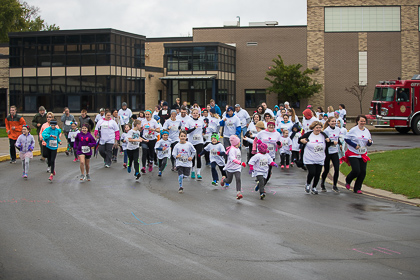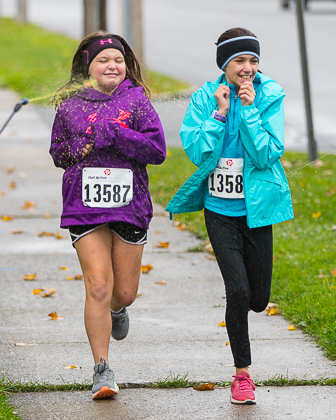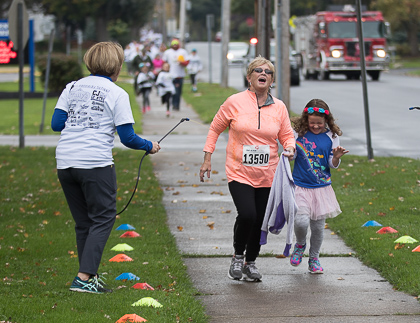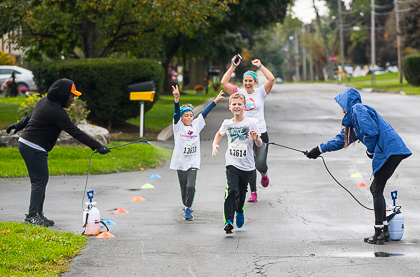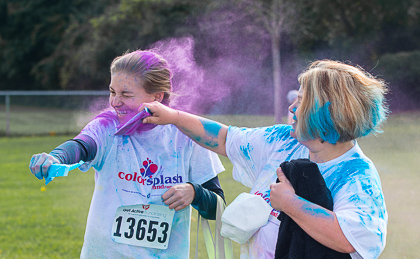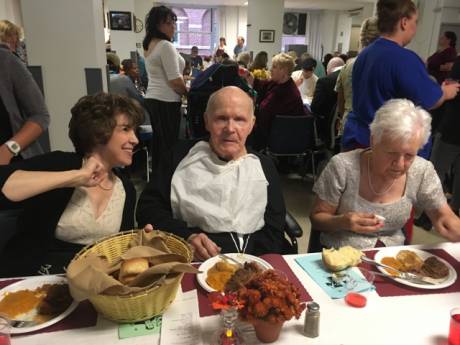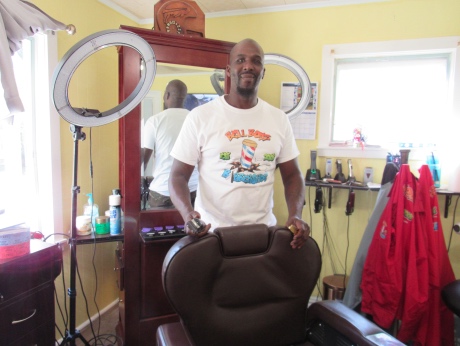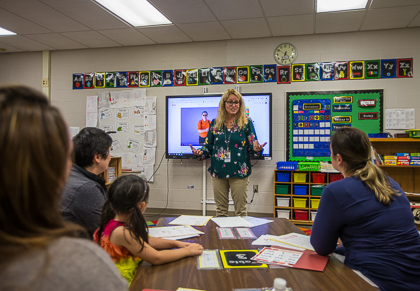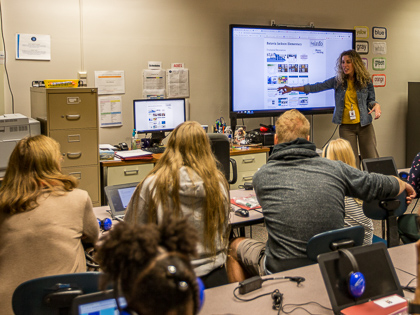In the middle of the 650-foot main corridor of the Buffalo Federal Detention Facility in Batavia, along a 50-yard section of white concrete block wall, are hand-painted images of flags from all over the world, dozens and dozens of them, one to represent each country for every detainee who has ever been held at the facility.
It's one of the first things a new detainee will see after going through the processing center and being led to the unit where the detainee will be held for the next several weeks, maybe months.
Some visitors who see the wall, said Thomas Feeley, field office director for Immigration and Custom Enforcement, think the flags represent "everybody who has been captured" by ICE, sending a negative message to detainees. But that's not at all how detainees take it, Feeley said. "There's an odd sense of pride" when they see the flag of their home country, knowing a fellow resident had been through the facility before.
"It makes them feel like they're not alone," Feeley said. "They realize nobody hates them because they are here illegally. It's just a process for them to go through."
A multicultural population
On any given day, there are 636 detainees in the facililty from as many as 80 different countries, said Jeff Searls, the facility's officer in charge.
Searls, Feeley, and Public Information Officer Khaalid Walls provided The Batavian with a tour of the facility Monday morning. It's the first time a reporter from a local media outlet toured the facility.
"The only two countries that have never been represented here are North Korea and the Vatican," Searls said, and he doesn't expect the Pope to enter the country illegally any time soon.
The average stay for detainees -- "detainees" are not "inmates" because the Buffalo Detention Facility is not a place for punitive confinment -- is 65 days. Searls explained that sometimes a detainee might be admitted who won't challenge deportion and they can be sent to their country of origin within days, while others might fight deportation, and depending on the court proceedings, can be held for a year or two.
"We don't want anybody here longer than they need to be," Searls said. "My goal is the shorter the stay the better."
The Bufffalo Detention Facility is one of the county's more significant employers, with 360 staff members in administration, maintenance, detainee supervision, medical and other services. Almost all of the employees come from Genesee County or one of the adjacent counties. Searls is from Genesee County and Feeley lives here as well and volunteers with his local fire department.
It's also the Federal government's most significant presence in Genesee County.
Only four other facilities like it nationwide
There are only four other similar facilities in the nation -- in Miami, Phoenix, and two in Texas -- Port Isabel and El Paso.
The facility's annual budget is somewhere between $30 million and $35 million, excluding medical expenses for detainees (which operates on a separate budget from what Searls administers).
Its two federal immigration courts are technically open to the public like any other courtroom, but the court calendar isn't easy to obtain. There is not a regular flow of information about detainee admissions or deportations.
And, of course, immigration and immigration enforcement is a hot political topic.
Yet, unless there's a protest outside its gates, its operations are nearly opaque to local residents. When it comes to immigration enforcement, even with this big federal presence, we rarely hear about what's going on right in our own backyard.
That is unlikely to change but it's also why The Batavian requested a tour.
We have no pictures from our tour because photography is prohibited inside the facility.
Most of the detainees at the facility have some prior criminal record before they're admitted, anywhere from 65 to 80 percent, with the balance being held purely on an immigration law violation, Searls said.
The process upon arrival
When a detainee arrives, they are held for up to 12 hours in a processing center. They are interviewed and given a medical exam. The process helps determine where best to place them in the population and whether they have any immediate medical concerns that would require them to be segregated or hospitalized.
Detainees being held on just an immigration violation are given a two pairs of blue pants and a blue shirt. Those with a non-violent criminal record (petit larceny, DWI, etc.) are dressed in orange. Those with violent felony convictions wear red.
Orange detainees can intermingle with blue or red detainees but blue and red are never placed in the same unit.
Besides criminal threat level, staff processing detinees must also consider country of origin and religious belief when deciding where to house a detainee. Typically, people from the same country enjoy sharing the same detainee unit but two people from the same country might belong to opposing tribes and two people who share a common religion might come from competing traditions (shch as Shia and Sunni Muslims), so it might be best to keep those individuals segregated from each other.
It can get complicated.
"We have somebody who has been doing that job for a long time," Searls said. "He's very professional."
The detention facility was built in 1998 and originally housed 425 detainees and prisonors for the U.S. Marshall's Office. It was expanded in 2013 and is now strictly an ICE facility.
Inside the walls
There are three diamond-shaped units on the west side of the facility, each with two wings. One wing is almost exclusively detainees in red uniforms with a common area ringed by locking cells with two beds each (except for the handicapped cells, which each contain one bed). Detainees are generally given unlimited access during the day to the common area for socializing and exercise. They are locked in their cells by 11:20 p.m.
In the other wing, there are two bays with common areas on the first floor and then bunk beds with lockers, no cells, on the first and second floors.
Both wings have TVs and a bank of phones that are accessible to detainees any time they want to make a phone call. Searls said there is one phone per six or seven detainees.
The detainees can also play ping-pong.
During designated hours, they can go outside where they can play soccer (the facilities most popular sport by far, Searls said), basketball or handball.
There is also an indoor basketball court, an entertainment library, where detainees can also take art classes, and across the hall from that library is a law library where detainess can research laws and legal cases. Some detainees choose to represent themselves. Others just want to double check their own attorneys.
There are also computers available in their holding areas available for legal research.
Detainees also have access to tablet computers that they can use to rent movies, TV shows, or books, through a private service, or make video calls to loved ones.
For female detainees, there is now a knitting class available.
Detainees can also study for the GED while held at the facility.
"These accomodations keeps them busy and keeps them happy," Searls said, noting that detainees who are busy and happy cause fewer problems.
Handling complaints and suggested improvements
But there are complaints, Searls said. If there is a complaint, it is fully investigated, even complaints against guards.
And staff is open to suggestions for improvements from detainees.
"A lot of the changes we've made over the past 20 years have come from suggestions by detainees," Searls said.
All communications, except for communications with attorneys are monitored.
The facility also has a medical facility that might best be described as an urgent care clinic. Detainees with any medical complaint have instant access. They can even report a medical problem from the tablets available to them in their cells.
Commander Charles McGee, an Air Force veteran, is in charge of the medical staff.
The staff includes a doctor, physician's assistance, nurses, a dentist and two psychologists.
Anything that requires hospitalization means the patient is transported, with guards, to UMMC or ECMC. If the detainee has surgery or needs other post-medical care, there are rooms in the unit available for recovery.
There are also isolation rooms for detainees with communicable diseases. While this might include flus and diseases like Ebola, the biggest concern is tuberculosis. Detainees are not transferred to their holding area until they've been cleared for TB. If the detainee won't allow a blood test, they are held in the processing area until a chest X-ray can be completed, which can take up to another 24 hours.
Receiving visitors and preparing meals
Once officially a detainee, detainees can receive vistors. There is a visitor area with a dozen private booths (the ones for detainees and their attorenys are slightly larger). In general, detainees can visit with family members for up to an hour, but when family members have made a long, special trip to visit a detainee, they might be able to visit for the full two hours in the morning, and the full two hours in the afternoon, and then again in the evening.
"They've come a long way, so we try to accommodate that as much as possible," Searls said.
As you might imagine, with a population of several hundred men and women from 80 different countries, some with medical conditions and a variety of religious beliefs or dietary habits, keeping them all properly fed can be a challenge.
The kitchen staff -- which includes trusted detainees -- prepares three meals a day -- for a total of 2,500 to 2,800 calories per day -- that are delivered to cells and dorms that accommodate those detainees' concerns. Though no meal ever contains any pork so that those with religious prohibitions against eating pork need not worry that their meals were prepared in a kitchen that also prepared pork.
"We do have turkey bacon," Searls said.
There is a religious advisor on staff and the facility does its best to accommodate every religious faith.
When trouble crops up
No facility with more than 600 people of various backgrounds, beliefs, and life experiences will always be peaceful. There are no gangs in the facility, Searls said, but that doesn't mean there are not gang members in the population. For the most part, the detainees are focused on dealing with their immigration cases and aren't house there long enough to form affiliations.
But when there are fights, the individuals are separated and taken to a section of the facility with isolation cells. The incident is investigated, which could lead to one participant or the other being held in isolation longer than the other. Searls said it's really just a cooling-off period. It's not like, he said, Attica or Pelican Bay, where inmates might be kept in solitary confinement for 60 days or longer. At most, a detainee is held in isolation for 10 days. While in isolation, they get one hour a day for outside their cell for exercise (Searls is only required to provide one hour every five days) and receive a daily visit from a staff psychologist.
Detainees can also request protective custody. That request is always granted without question, Searls said. Even if staff might suspect paranoia, the request for protective custody in an isolation cell is always granted.
"If someone has an issue, even if it's just in their own mind, if they feel it's necessary, I don't tell them they don't," Searls said.
By no means a vacation spot, but scores high on accreditation
If anything about our story makes it sound like the Buffalo Federal Detention Facility is a country club, it's not. With nearly uniformly white walls and gray doors, thick, concrete block, windowless walls, constant monitoring, hours of confinement to a limited space, meals and snacks only on schedule, some limits on contact with the outside world, being locked up with people you didn't choose to hang out with, and very few opportunities to see the sun, this is no Miami Beach vacation. It's serious business.
And it's a business Searls and Feeley are clearly proud to lead. Of the five ICE detention facilities in the United States, they think the best one is in Batavia. The facility scored a 99.4, out of a possible score of 100, in a recent accreditation by the American Correctional Association.
The facility has in fact scored well in every accreditation and review it has received. It was important to Searls and Feeley that readers know how well it does on its audits and inspections, which Searls said is a credit to the staff and Feeley said the facility has good staff because of the strong, blue-collar work ethic of Western New Yorkers.
The facility has always drawn its staff from the region and in its 20th year it boasts of having little turnover; many of the new staff members are relatives, even sons and daughters, of current or former staff members.
"You're usually not going to have family seek employment at some place that isn't a good place to work," Searls said.
Screen capture from the Genesee County GIS Mapping Service.



